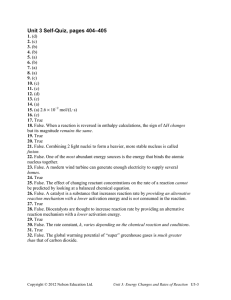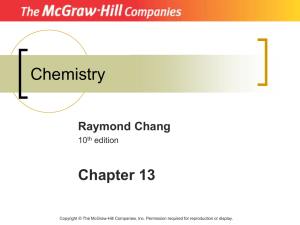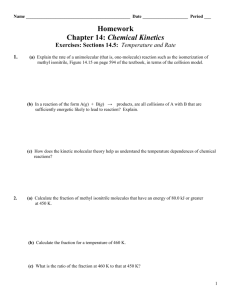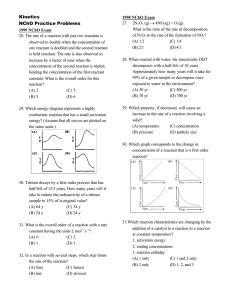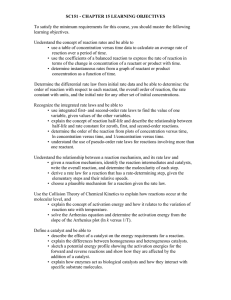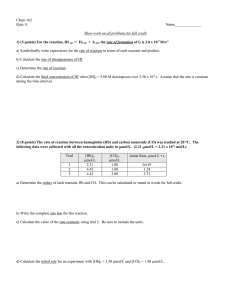15 Chemical Kinetics
advertisement
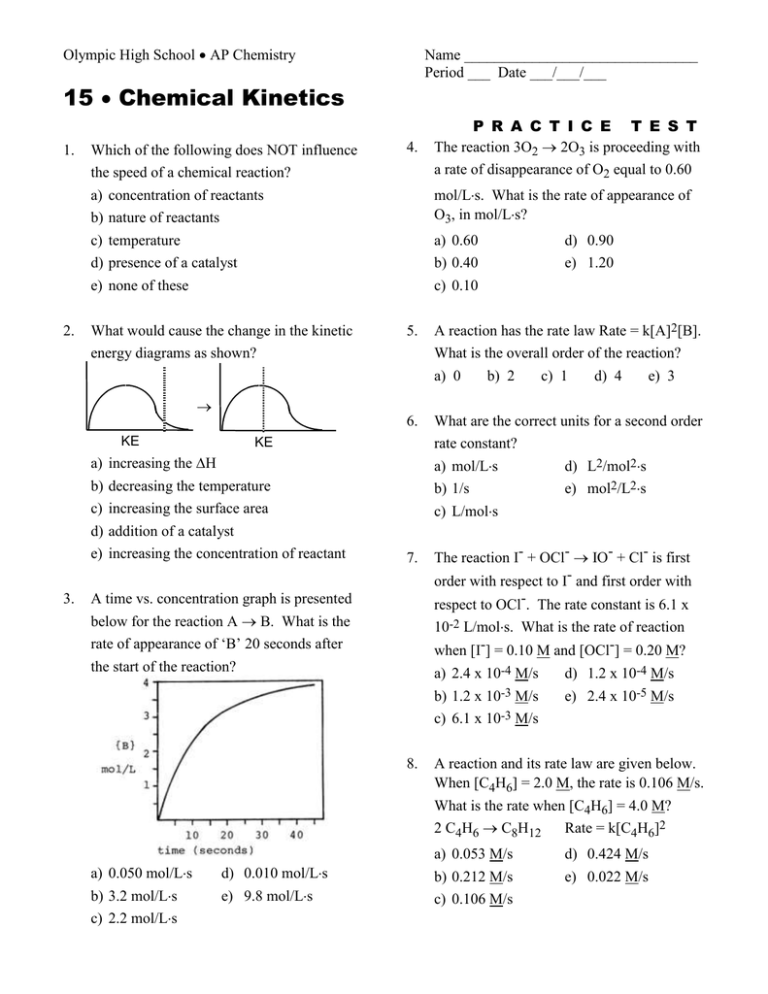
Olympic High School AP Chemistry Name _______________________________ Period ___ Date ___/___/___ 15 Chemical Kinetics 1. 2. Which of the following does NOT influence the speed of a chemical reaction? a) concentration of reactants b) nature of reactants c) temperature d) presence of a catalyst e) none of these 4. What would cause the change in the kinetic 5. P R A C T I C E T E S T The reaction 3O2 2O3 is proceeding with a rate of disappearance of O2 equal to 0.60 mol/Ls. What is the rate of appearance of O3, in mol/Ls? a) 0.60 b) 0.40 c) 0.10 energy diagrams as shown? d) 0.90 e) 1.20 A reaction has the rate law Rate = k[A]2[B]. What is the overall order of the reaction? a) 0 b) 2 c) 1 d) 4 e) 3 KE 6. What are the correct units for a second order rate constant? a) mol/Ls d) L2/mol2s b) 1/s e) mol2/L2s c) L/mols 7. The reaction I- + OCl- IO- + Cl- is first order with respect to I- and first order with KE a) increasing the H b) decreasing the temperature c) increasing the surface area d) addition of a catalyst e) increasing the concentration of reactant 3. respect to OCl-. The rate constant is 6.1 x A time vs. concentration graph is presented below for the reaction A B. What is the rate of appearance of ‘B’ 20 seconds after the start of the reaction? 10-2 L/mols. What is the rate of reaction when [I-] = 0.10 M and [OCl-] = 0.20 M? a) 2.4 x 10-4 M/s b) 1.2 x 10-3 M/s c) 6.1 x 10-3 M/s 8. a) 0.050 mol/Ls b) 3.2 mol/Ls c) 2.2 mol/Ls d) 0.010 mol/Ls e) 9.8 mol/Ls d) 1.2 x 10-4 M/s e) 2.4 x 10-5 M/s A reaction and its rate law are given below. When [C4H6] = 2.0 M, the rate is 0.106 M/s. What is the rate when [C4H6] = 4.0 M? 2 C4H6 C8H12 Rate = k[C4H6]2 a) 0.053 M/s b) 0.212 M/s c) 0.106 M/s d) 0.424 M/s e) 0.022 M/s 9. The rate law for the reaction 2NO(g) + O2(g) 2NO2(g) is Rate = k[NO]2[O2]. What happens to the rate when the concentration of NO is doubled? a) the rate doubles d) the rate is halved b) the rate triples e) none of these c) the rate quadruples 10. Below is some rate data for the hypothetical reaction, 2A + B C. What is the rate law for this reaction? Experiment 1 2 3 [A]o 2.0 M 2.0 M 4.0 M [B]o 1.0 M 2.0 M 1.0 M Rate (M/s) 0.100 0.400 0.100 a) Rate = k[A][B] d) Rate = k[A]2[B]2 b) Rate = k[A]2[B] e) Rate = k[B]2 c) Rate = k[A][B]2 11. The acid catalyzed decomposition of hydrogen peroxide is a first order reaction with the rate constant given below. For an experiment in which the starting concentration of hydrogen peroxide is 0.110 M, what is the concentration of H2O2 450 minutes after the reaction begins? 2H2O2 2H2O + O2 k=1.33 x 10-4 min-1 a) 0.0961 M b) 0.104 M c) 0.117 M d) 0.00658 M e) 0.0156 M 13. What fraction of a reactant remains after 3 half-lives of a first order reaction? a) 1/2 b) 1/3 c) 1/6 d) 1/8 e) 1/12 14. Assume a reaction occurs by the mechanism given below. What is the rate law for the reaction? A+BC fast CD slow a) Rate = k[A][B][C] b) c) d) e) Rate = k[A]2 Rate = k[A][B] Rate = k[A][B]/[D] Rate = k[A] 15. According to collision theory, which of the following factors does NOT influence the rate of reaction? a) collision frequency b) c) d) e) collision energy collision orientation collision rebound direction none of these 16. What distance corresponds to the activation energy for the reaction of X to Y? 12. What is the rate constant for a first order reaction for which the half-life is 85.0 sec? a) 0.00814 sec-1 d) 0.0118 sec-1 b) 4.44 sec-1 e) 58.9 sec-1 c) 0.170 sec-1 a) a b) b c) c d) d e) e 17. At what point on the potential energy diagram given below does the transition state (activated complex) occur? a) a d) d b) b c) c e) e 18. Which of the following is NOT true about a catalyst? a) b) c) d) e) it speeds up the forward reaction is acts as an inhibitor it speeds up the reverse reaction it may be homogeneous it may be heterogeneous 21. Which energy diagram represents a highly exothermic reaction that has a small activation energy? (Assume that all curves are plotted on the same scale.) 22. Tritium decays by a first-order process that has half-life of 12.5 years. How many years will it take to reduce the radioactivity of a tritium sample to 15% of it original value? (A) 64 y (C) 34 y (B) 54 y (D) 24 y 23. What is the overall order of a reaction with a rate constant having the units L·mol-1·s-1? (A) 0 (C) 2 (B) 1 (D) 3 19. A free radical is a chemical species that possesses a) b) c) d) e) a positive charge a negative charge an unpaired electron an oxygen atom unconventional political views 24. In a reaction with several steps, which step limits the rate of the reaction? (A) first (C) fastest (B) last (D) slowest 25. 20. The rate of a reaction with just two reactants is observed to double when the concentration of one reactant is doubled and the second reactant is held constant. The rate is also observed to increase by a factor of nine when the concentration of the second reactant is tripled, holding the concentration of the first reactant constant. What is the overall order for this reaction? (A) 2 (C) 5 (B) 3 (D) 6 2N2O5 (g) 4NO2(g) + O2(g) What is the ratio of the rate of decomposition of N2O5 to the rate of the formation of NO2? (A) 1:2 (C) 1:4 (B) 2:1 (D) 4:1 26. Which property, if decreased, will cause an increase in the rate of a reaction involving a solid? (A) temperature (C) concentration (B) pressure (D) particle size 27. Which reaction characteristics are changed by the addition of a catalyst to a reaction at constant temperature? 1. activation energy 2. ending concentrations 3. reaction enthalpy (A) 1 only (C) 1 and 2 only (B) 3 only (D) 1, 2, and 3 28. A plot of reactant concentration versus time gives a straight line. What is the order of the reaction for this reactant? (A) zero (C) second (B) first (D) some other value 29. Which change does not increase the value of the rate constant for a reaction? (A) decreasing the activation energy (B) raising the temperature (C) adding a catalyst (D) increasing the concentration of reactants 30. A certain reaction has a H = -75 kJ and an activation energy of 40 kJ. A catalyst is found that lowers the activation energy of the forward reaction by 15 kJ. What is the activation energy of the reverse reaction in the presence of this same catalyst? (A) 25 kJ (B) 60 kJ 31. (C) 90 kJ (D) 100 kJ Nitrogen(II) oxide and hydrogen react to form nitrogen and water according to this equation. 2NO(g) + 2H2 N2(g) + 2H2O(g) According to these experimental results, what are the orders for NO and H2O? [NO] [H2] Rate(M min¯1) 0.015 0.020 0.60 0.015 0.040 1.20 0.030 0.020 2.40 Order; NO Order; H2 (A) 1 1 (B) 1 2 (C) 2 1 (D) 2 2 32. At a certain temperature the first-order decomposition of hydrogen peroxide exhibits these data. time (seconds, s) [H2O2](mol L¯1) 0 2.0 15 1.0 At what time will the [H2O2] = 0.50 mol L¯1? (A) 30. s (C) 22 s (B) 25 s (D) 20. s
